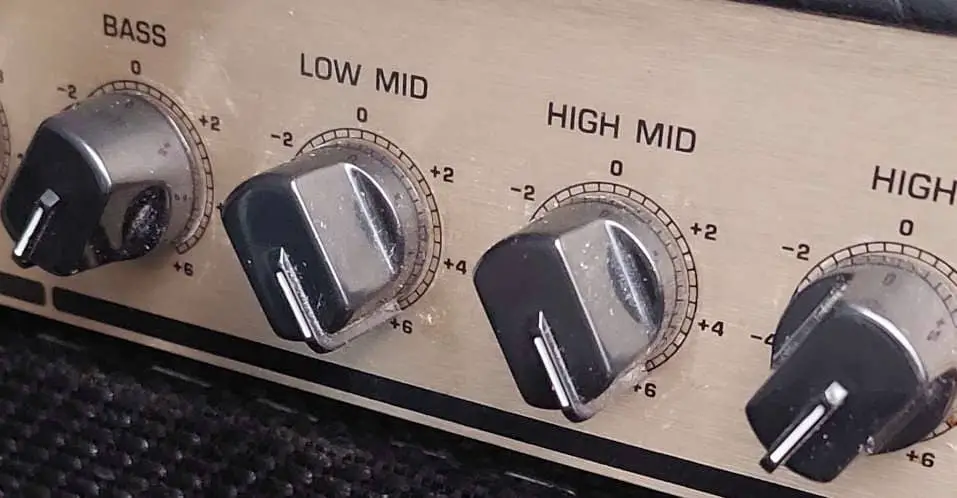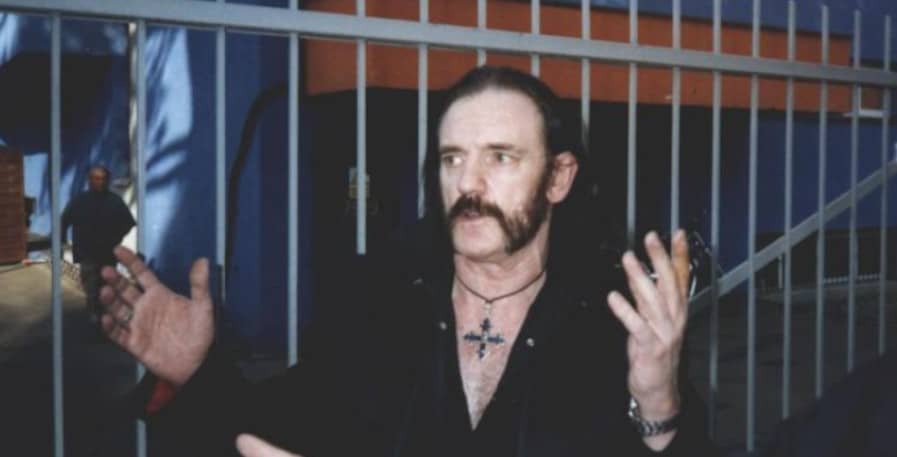Ian Fraiser “Lemmy” Kilmister was one of the most unique and iconic bass players of all time. While most bassists prefer a smooth and low-end heavy tone, Lemmy`s bass tone was distorted, and mid-range heavy.
He also often strummed the bass rather than playing individual notes. For these reasons, Lemmy has inspired countless aspiring rock and metal bassists.
Therefore, I decided to write this article to help out anyone who is looking to emulate Lemmy`s bass tone.
I will show you Lemmy`s amp and EQ settings. We will also take a look at how he got his tone without the use of pedals. Then, we`ll go over the other details that fleshed out his tone, such as what tuning he used, as well as pick and string choice.
Lastly, we`ll take a look at what instruments he played, and how you can recreate Lemmy`s bass tone without having to buy yourself a Rickenbacker.
Did Lemmy use a distortion pedal?
Contrary to popular belief, Lemmy did not use a pedal to achieve his distorted bass tone. Rather, the distortion was produced by playing his Marshal Super Bass at a high volume with his mid-range turned up.
Nowadays, distortion pedals are commonplace among bassists in heavy genres. Yet, the one bassist who is known for his distorted tone did not actually use one.
If you can play with the same gear as Lemmy, you won`t have to rely on a distortion pedal either. There are however two problems with this:
- Supply and demand – It is both hard and expensive to get your hands on the same gear Lemmy used. This is in large part because a lot of his gear is in limited supply.
- You (probably) don`t tour stadiums – Small band rehearsal spaces and concert venues will make it difficult for you to play loud enough to get the amount of distortion you are looking for.
Thus, despite him not using a distortion pedal, my recommendation is to use one. If you want to sound like Lemmy your bass needs to sound distorted one way or another. A pedal will by far be the easiest way to achieve this.
Most distortion pedals will get you fairly close. If you are getting one for the specific purpose of sounding like Lemmy, my recommendation is the AZOR Distortion. This is because it has a “classic mode” which has a UK-style gain with warm mids, which is exactly what you want to be aiming for.
Lemmy`s amp settings and EQ
Conventional rock and metal bass EQ wisdom will tell you to never turn any knobs all the way up or down. Lemmy, on the other hand, has stated that he does exactly this to all his knobs.
“I don’t use any effects. On my amp, I turn the bass off, the treble off, the middle is full on, and I’m at about three o’clock with the presence and two o’clock on the volume—on both stacks. I have two ’70s Marshall stacks. They go through 15″ and 4×12 speaker cabs.”
Lemmy Kilmister – 2015 Interview
Thus, to recreate Lemmy`s amp settings, your dials should look like this:

On their own, these settings will produce a thin and hollow sound. It is the volume and presence of marshal amps and the added distortion that makes this tone sound heavy and piercing.
Lemmy also turned the bridge pickup up and the neck pickup down. Soloing the bridge pickup results in a brighter tone and brings life to the mid-range frequencies. Given that Lemmy`s tone was so centered around the mid-range, this played a major part in shaping his sound.
What pick did Lemmy use?
Lemmy used 1.14mm Dunlop nylon picks to play the bass. These picks were thick enough to support his heavy use of chords and thin enough to fit his bright and mid-range heavy tone.
1.14mm is a common thickness and slightly thinner than the average 1.17mm thickness of bass picks.
“You know, I chose to play with a pick. Because of Lemmy, he plays with a pick. Much thicker pick than I use.”
Duff McKagan of Guns N` Roses – 2021 interview with Softtube.
As for picking style, Lemmy picked the strings aggressively and with a lot of force. Lemmy also preferred to play close to the neck, rather than the bridge.
One reason for this is that the strings feel looser to play at this spot. Given that Lemmy regularly played fast chords progressions, playing closer to the neck made these chords more resonant and easier to play.
To recreate his tone, an average-sized bass pick, preferably in nylon, will do the trick. If you want the real deal, Dunlop has released a signature Motörhead pick. Lemmy also used to play with this signature pick himself. This is one of the more affordable ways to emulate Lemmy. Plus, they look really cool.
What strings did Lemmy use?
Lemmy used his signature Dunlop stainless steel bass strings with gauges of .105-.085-.070-.050. towards the end of his career. He used Rotosound swing 66 strings in his early days before moving on to Dean Markley stainless steel strings with gauges of .105-.080-.065-.045 in the 90s.
While Lemmy has played various sets of strings throughout his life, neither the character nor the gauges of the strings changed a whole lot.
He always played stainless steel strings, which have a bright sound that suits a mid-range heavy tone. They are also more durable than plain steel and nickel strings, which certainly helped when playing as aggressively as he did.
In his later years, he played his own signature strings, which were developed by Dunlop. These are available to the consumer market and are the strings I would recommend for anyone who is looking to emulate Lemmy`s tone.
What tuning did Lemmy use?
Throughout his career with Motörhead, Lemmy mainly tuned his bass to Eb standard. This meant that his strings were tuned Eb-Ab-Db-Gb. He also occasionally tuned to E standard, meaning his strings were tuned E-A-D-G for certain songs.
Two common reasons bands tune to Eb standard are to sound heavier and to support a vocalist with a deep vocal range
While we can`t know Lemmy`s exact reasoning, it is fair to assume that these would both be good reasons for him to choose this tuning over E standard.
Eb is a tuning that luckily doesn`t require a lot of setup. This means you can safely tune your bass down half a step to emulate Lemmy`s tone without having to worry about switching strings or adjusting the truss rod on your bass.
What bass amp did Lemmy use?
Lemmy`s main bass amp, “Murder One”, was a customized 1976 Marshal Super Bass. He played this amp until 2007, at which point he switched to the 1992LEM. This was a Marshal-developed amp designed to emulate the sound of his original Super Bass.
For this reason, Lemmy`s bass sound has been loud and consistent throughout Motörhead’s entire career.
As for cabinets he has mainly used a Marshall 1979L 4×15 and a Marshall MF280L 4×12. This is an unconventional choice for a bass player and one that would be more commonly used by guitarists. However, as with everything Lemmy, he broke the rules and still managed to make it work.
While using the abovementioned gear is the best way to replicate Lemmy`s sound, this rig will be pretty overkill for most bassists out there.
Furthermore, both the 1976 Super Bass and 1992LEM are hard to come by and in limited supply. Thus, you won`t always find either listed for sale. If you happen to come by one, it will be at a high price.
Therefore, if you are looking to invest in an amp with the goal of sounding like Lemmy, a Marshal amp at whatever price range you are comfortable with will generally be your best bet.
“I have never found anyone better to have at my back. If it has Marshall written on it, you can buy it without even a test drive; they’re that good.”
Lemmy Kilmister – Premier Guitar
What bass did Lemmy play?
In Motörhead, Lemmy played a wide range of Rickenbacker Basses. Among others, he played a 4000, 4001, 4003, and custom 4004LK. These bass guitars were heavily modified by Lemmy and he regularly switched out individual parts on his instruments.
The fat and resonant sound of Rick`s makes them stand out from your typical bass. They have a distinct and clear mid-range, which was the perfect fit for Lemmy. These basses thus played a major part in shaping Lemmy`s signature bass tone.
However, he was also a big fan of modifying his basses. He did everything from switching out the pickups to changing the knobs on his ricks. Thus, while Rickenbackers are the go-to instrument for a Motörhead sound, you might still not get the exact same tone out of them as Lemmy.
While Rickenbackers are the best basses for recreating Lemmy`s sound, you can also get close with many other basses.
I consider the best second options for recreating Lemmy`s tone to be the Gibson Thunderbird and the Gibson SG.
Lemmy played both of these basses in Motörhead. Thus, I believe the best second choices are Lemmy`s own second choices. Other good options include the Fender Jazz and Music Man Stingray as these basses have a wide range of tonal options and have shown their worth in heavy genres in the past.
Conclusion
While recreating Lemmy`s bass tone exactly is a tall order, you can get fairly close without his exact gear.
The most crucial part is to turn down the low and high frequencies and turn up the mid-range. You also need distortion, which I would recommend using a pedal for despite Lemmy not using one himself. Make sure to turn your bridge pickup up and neck pickup down so that your tone becomes even more piercing.
As for playstyle, pick the strings hard with a medium-sized bass pick. Pick the strings somewhere between your neck and your neck pickup so that they feel sloppy enough to pick comfortably and resonate well. Use stainless steel strings for their bright tone, and opt for gauges of .105-.085-.070-.050.
Tune your bass to Eb standard to play in the same key as Motörhead did. Play power chords at fast tempos, and most importantly, make sure to turn up the volume.
If you do all of these steps, it will be hard for most listeners to tell the difference between Lemmy`s bass tone and yours.
While singing and playing bass is difficult, Lemmy made it look completely effortless. If you are looking to sing while playing the bass like him, check out my guide on how to sing and play bass at the same time.

